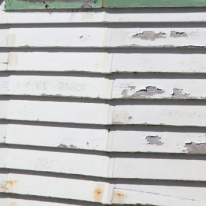Painted timber weatherboards – peeling or flaking paint
Listed under: Exterior, finishes, timber and wood-based, paint, timber, cladding, walls, moisture, wall cladding, painted timber weatherboards, lead-based paint
Cause
Thermal expansion and contraction of timber substrates
Repair
-
scrape and/or sand off loose paint. Sand bare timber until surface is sound, remove dust and then prime. Fill cracks or holes in the timber surface with an exterior grade flexible (polyester) filler. Paint with a minimum two coats of good quality semi-gloss or high gloss acrylic paint
-
select paint of a lighter colour – darker colours attract heat, which can cause greater expansion/contraction of the timber and thus a reduced service life for the paintwork
-
with houses over 40 years old, be aware that old layers of paint may contain lead. Lead can be a health hazard if fumes, dust or paint fragments are swallowed or breathed in. For more information see Health and safety: lead-based paint
Cause
Loss of adhesion due to excess moisture in substrate
Repair
- follow the preparation and repainting guidance for the first repair. Be careful with preparation, ensuring the substrate is completely dry before painting begins.
Cause
Poor initial substrate preparation
Repair
- follow the preparation and repainting guidance for the first repair. Be careful with preparation, ensuring the substrate is completely clean and dry before painting begins.
Cause
Oil-based (alkyd) paint applied over water-based (acrylic) paint
Repair
-
oil-based paint should generally not be applied over water-based paint. To determine whether an existing paint finish is water-based or solvent-based:
-
soak a cotton ball in rubbing alcohol (isopropyl or ethyl alcohol), an acetone-based nail polish remover or lacquer thinner
-
rub it over a small, inconspicuous section of wall
-
if paint comes off, it is water-based; if unaffected, it is a solvent-based paint
-
follow the preparation and repainting guidance for the first repair. Apply at least two coats of good quality high-gloss or semi-gloss water-based paint.
Cause
Surface was damp or dirty when painted previously
Repair
- follow the preparation and repainting guidance for the first repair. Be careful with preparation, ensuring the substrate is completely clean and dry before painting begins.
Cause
Dark colours
Repair
- follow the preparation and repainting guidance for the first repair. Scrape off the old dark-coloured paint. Repaint with a good quality high-gloss or semi-gloss acrylic paint in a lighter colour. Darker colours attract heat, which can cause greater expansion/contraction of the timber, and thus a reduced lifespan for the paintwork.
Cause
Timber swelling/shrinkage caused by moisture absorption into timber end grain if joints were not adequately primed before installation
Repair
- follow the preparation and repainting guidance for the first repair. After scraping and removing loose paint, pay particular attention to any joints, gaps, cracks or splits in the weatherboards. Ensure they are primed and/or filled with flexible filler as appropriate before painting – follow the product manufacturer’s guidance.
Cause
Paint coating is not thick enough on sharp board corners
Repair
- follow the preparation and repainting guidance for the first repair. Ensure very sharp corners are rounded when sanding to help paint to adhere.






